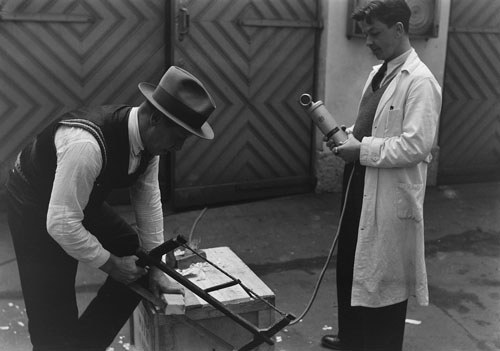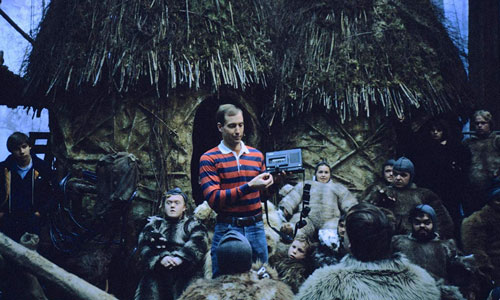The Sound and the Fury
How sound design—such as the iconic Indiana Jones whip noise—has come to define the film industry almost as much as all the on-screen effects.
Hey all, Ernie here with a piece from Andrew Egan about a specific kind of movie magic—the kind you hear, whether during a dramatic fall or the crack of a whip. Enjoy!
Sponsored By … You?
If you find weird or unusual topics like this super-fascinating, the best way to tell us is to give us a nod on Ko-Fi. It helps ensure that we can keep this machine moving, support outside writers, and bring on the tools to support our writing. (Also it’s heartening when someone chips in.)
152
The number of films that use the infamous “Wilhelm scream”, a stock sound effect of a man screaming, according to IMDB. (Wikipedia lists 388, citing the same IMDB page, but their number may also include TV series which have also featured the scream.) Originally used in the 1951 film Distant Drums in a scene where an alligator bites the arm off a cowboy, the scream has appeared in films ranging from Star Wars and Toy Story to Reservoir Dogs and Lethal Weapon 4. What has now become an inside joke for sound designers was popularized by a legend in the field. (Anyone that fell in love with British panel shows and binge-watched QI clips on YouTube might already know about this.)

An example of foley work from the 1930s. (Wikimedia Commons)
The often overlooked work that makes movies magic
Like acting, sound design actually precedes the art of filmmaking.
For centuries, theater productions would enhance their shows with sound effects and music. In the 20th century, sound design (the creation of which is often called foley) found its way into cinema and radio broadcasts. Many of the techniques used to create sound effects in film and radio were pioneered by Jack Donovan Foley, a sound designer at Universal who moved into cinema after the debut of The Jazz Singer, the first non-silent motion picture.
There is a slight difference between foley and sound design. After researching various forums and videos, the primary distinction between the two is that foley tends to be limited to human and natural sound, like footsteps or the rumple of a jacket. In other words, foley is limited to the sounds human create by themselves or interacting with their environment.
As visual effects opened the possibilities of what could be depicted on screen, a new generation of sound designers needed to develop sounds for what previously unimaginable.
10
The number of Academy Award nominations for Ben Burtt, largely in sound design categories. In addition to his two wins, he’s also received two Special Achievement certifications for singular contributions to the individual films he worked on, Star Wars and Raiders of the Lost Ark. He was also nominated in the short documentary category for a film he made, Special Effects: Anything Can Happen, a look at the special effects in major Hollywood films.

Iconic sound designer Ben Burtt, shown on the set of Return of the Jedi. (via IMDB)
One guy is responsible for many of the iconic sounds from influential movies
What does a spaceship sound like?
There’s no right or wrong answer, of course, but some sounds are more believable for whatever reason. For years, sci-fi languished as fodder for B-movies, but Star Wars changed the course of modern movies. Visual effects were coming into a new era, and Ben Burtt helped create the sounds that punctuated villains, heroes, and the tools they used.
The individual list of sound effects Burtt created on his way to two Academy Awards, two Special Achievement certificates, and a 43-year career in Hollywood is insane. Burtt is personally responsible for:
- The voice of R2-D2 in the original Star Wars trilogy
- The blaster sound effect in Star Wars
- The breathing effect of Darth Vader
- The hum of the lightsaber
- The voice of WALL-E
His work with George Lucas and Steven Spielberg intertwined with the astonishing visuals on screen. When anyone uses their broom to mime a lightsaber, it is almost always accompanied with a hum or a vroom, vroom. With this one addition alone, Ben Burtt would have been immortalized in movie history. But he made a much bigger impact by religiously including the Wilhelm scream in dozens of films. He also convinced a bunch of his colleagues to do the same. He even got to do his own version of the scream when he played Colonel Dyer, an Imperial officer that was knocked off a walkway to his death by Han Solo in Return of the Jedi.
The otherworldly plots and designs of sci-fi required a special touch and sense of awe. Burtt notoriously employed manipulation of sounds he encountered. For a swashbuckling archaeologist battling Nazis and Soviets for possession of relics of extreme significance, Burtt had to redefine a movie staple and make it all his own. He needed to redefine the sound of violence.
776
The number of pounds of force elite level boxers can potentially inflict on an opponent, per a study of 70 boxers. At the top level, a boxer can reach 1,400 pounds of force. If delivered to the head, this is enough to generate the equivalent of 53 times the force of gravity The characters in the Indiana Jones franchise aren’t hitting with near the same force, yet it somehow sounds harder. When Indy gets punched, it sounds like it hurts.
It takes a lot to land a good punch
For understandable reasons, Burtt tends to keep the exact method creating some of his iconic sound effects to himself and his bosses at Skywalker Sound, now a part of the Walt Disney Company. He will reveal some of the basics of his classics, like that the blaster sound comes from banging on a guy wire. But he rarely specifics exactly how he modified the the natural sounds he captured. Sure, he talks about how his electric razor was used to create some of the characters in WALL-E but Burtt doesn’t tell you the model or how he played with it in the studio.
Still, there are aspiring sound designers that emulate Burtt and attempt to recreate some of his iconic effects. The Sound Keeper, a blog maintained by LA-based sound designer Jeremy Rogers, detailed his effort at recreating the Indiana Jones punch. His multi-step process to recreate the punch is valiant but ultimately sounds a bit off when compared with the real thing. It does have the same snap because both effects use the sound of a David Morgan Bullwhip, the one Indy used in the films.
Burtt said in a featurette of the movie, “We did it in different environments. We did it in the trees, out in the middle of a field, and we built up a library of whip cracks which was the basis of Indy’s sound.”
The Indiana Jones punch was created by blending baseball bats hitting leather and the crack of Indy’s whip. You can hear the leather when someone, often Indy himself, gets a good one in the kisser. It’s a sound that quickly and not so quietly informs us that our hero gets hurt. He earns his inevitable victory. One punch at a time.
Ben Burtt is still at Skywalker Sound, though his importance seems to be limited these days. The man Spielberg called the “father of Skywalker Sound” had worked on every Star Wars from “A New Hope” to “The Force Awakens”. His talent however, was not utilized on “The Last Jedi” for reasons that are unknown even to him.
The franchise does seem to be moving on without him. He apparently submitted a sound design for newest fan favorite BB-8, but lost out to the version J.J. Abrams produced with Saturday Night Live alum Bill Hader. Considering the character’s success, Disney is probably happy with their decision.
Whatever his future with Disney, Ben Burtt is a film icon. Someone who gave definitive sounds to our imaginations. Millions know what a light saber sounds like. They can mimic Darth Vader’s breathing and imagine the sore jaw Indy must perpetually suffer. And best of all, he gave us the soundtrack to a fatal fall.
:format(jpeg)/2018/08/tedium073118.gif)
/2018/08/tedium073118.gif)


/uploads/andrew_egan.jpg)